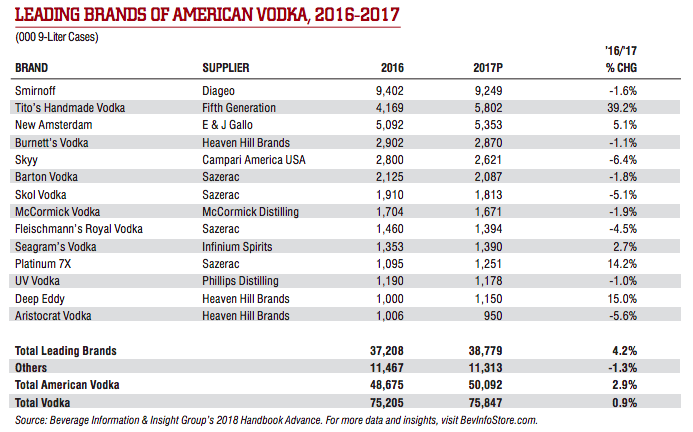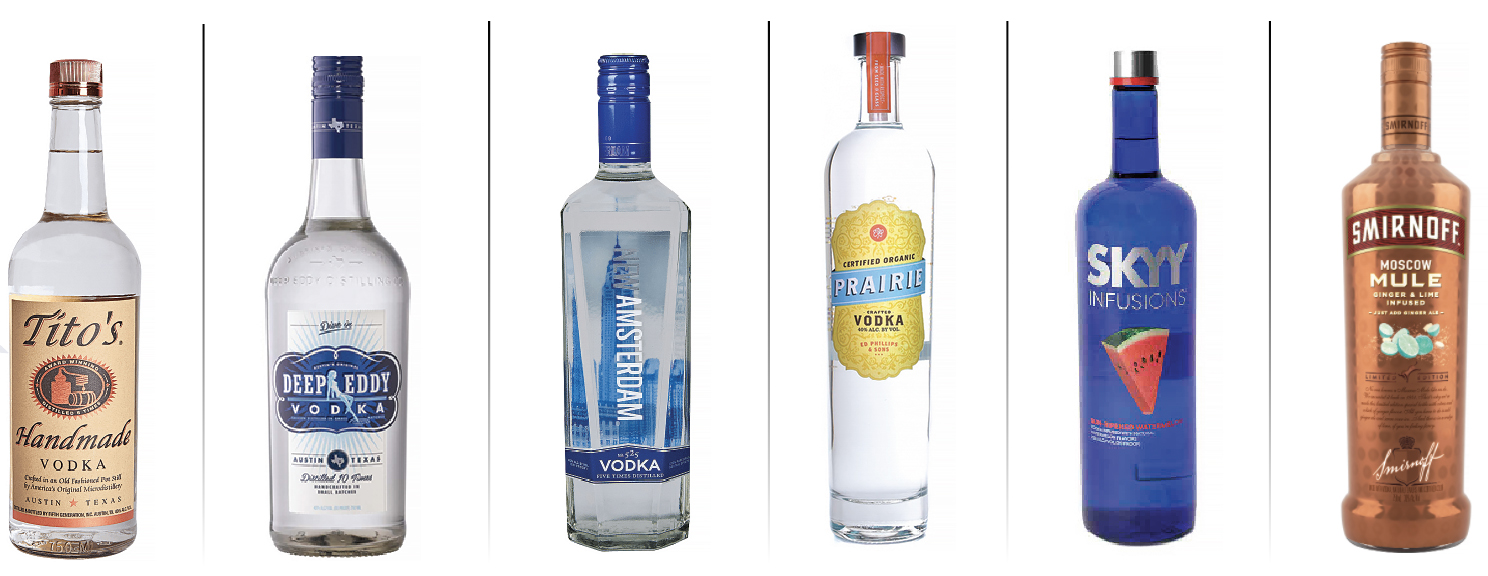Domestic vodka, like America itself, is diverse, with distinct DNA for each brand. Lately, American-made vodka has lots to celebrate. The quality is there, sales are up and brands are proliferating – sea to shining sea.
“Recently, American vodka brands have stepped up their game and have been focusing on distillation, quality of original ingredients and the care put into production,” says Michael Sachs, director of marketing for E.&J. Gallo Winery, parent of the New Amsterdam brand.
The vodka category enjoyed another year of solid growth in 2017, according to the Distilled Spirits Council (DISCUS), with volumes up 2.2% and revenues up 3% to $6.2 billion. Vodka sales were paced by high-end premium products with revenue growth of more than 15% to $1.6 billion.
“Over the past few years a number of American distilleries have cropped up and created a renewed interest in American-made spirits,” says Ryan Robertson, brand manager for American Anthem Vodka, the latest entrant in Diageo’s vodka portfolio. “The game has really changed for consumers in terms of domestics versus imports.”
What is American Style?
While the TTB defines vodka as “neutral spirits without distinctive character, aroma, taste or color,” that doesn’t do the American spirit justice. Each brand offers nuances in aroma and flavor, as distillers imprint their own stamp on the white spirit. And beyond the specifics of ingredients, distillation and filtration processes, a brand’s DNA can embrace such intangibles as a pride of place and a sense of community.
“While American vodkas may differ in terms of the materials they are made from, what really defines them is the true American entrepreneurial spirit and how they reflect the person who created them or where they are from,” says Melanie Batchelor, VP of marketing for Campari America. “That’s opposed to many international vodkas, which are motivated by tradition or process.” Key to Skyy Vodka’s DNA, she adds, is that it was founded in San Francisco by a first-generation American who also happened to be an inventor.
Domestic vs. Import
Do American vodka drinkers understand the differences between domestic and import brands? And, if so, do they care? The answer is yes, no and maybe.
“Consumers care, but not like they would with bourbon or tequila,” says Nathan Ruiz at Sodie’s Wine & Spirits in Fort Smith, Arkansas. The retailer adds that, “The most-asked questions about vodkas are if the product is local, if it is low in calories and if it is gluten-free.”
“Some, but not all, American consumers differentiate between domestic and imported vodkas,” says Nakhil Shah, Smirnoff’s marketing director. Smirnoff is made and bottled in the American heartland, in Plainfield, Illinois. It’s distilled from corn, and the liquid is then filtered 10 times through charcoal. “In the U.S., vodka is the most widely consumed spirit and therefore consumers have a broad understanding of the category, as well as access to many imported and domestic options,” he adds.
“The lines between domestic and imported vodkas have blurred,” says Sachs at E.&J. “There has been an extraordinary shift of Americans purchasing domestic vodkas over the past decade. Americans recognize that they can find quality domestic vodkas that can compete with imported vodkas across many price points.” New Amsterdam Vodka is five times distilled and three times filtered, which results in a clean, crisp taste, according to Sachs.
“Consumers are becoming more interested in the authenticity and story behind brands,” says Lauren Cherry, communications manager for Heaven Hill Brands. Deep Eddy’s brand story has an authentic Austin heritage and portrays a uniquely American lifestyle. Burnett’s Vodka is a quintessential family-owned and -operated company. Burnett’s Vodka just underwent a major rebrand for the first time in 25 years, including a redesign of the bottle and package.
“Historically, there has always been a comparison to Russian vodka, but I think these ideas are fading with the millennial generation,” says Lyndsey Reimers, brand manager at Phillips Distilling, whose portfolio includes Prairie Organic and UV vodka brands. “As with all things, ‘Made in the USA’ carries a strong point of difference.”
American Pride Sells

“Brands that focus on their American heritage are a sub-segment that is leading the growth of vodka,” Robertson says. American Anthem Vodka, as the name implies, boasts a strong connection to flag and country. Indeed, the label incorporates the Stars and Stripes motif and announces “Proudly Made in America.” Social media taglines include “Salute the American Spirit,” “Celebrate the American Spirit” and “Rekindle the American Spirit.”
“We wanted to leverage the fact that American-made was a big interest in the category, as well as a value proposition,” says Robertson about the strategy behind the brand launch. “To create a broadly appealing vodka that was authentically American-made that offered premium quality and great value to consumers.” American Anthem Vodka is made from corn grown in Iowa and Indiana and the liquid is five times distilled. “It is also gluten-free, which is important for a lot of consumers,” Robertson notes.
“We couldn’t be prouder to be distilled in America and we absolutely lean into our American heritage in everything we do,” says Batchelor about Skyy Vodka. Recently the brand launched its “Proudly American” marketing campaign, which juxtaposes famous phrases from American history – such as “Home of the Brave” – with imagery featuring people who celebrate diversity.
“Smirnoff is proud to be made in America since 1934 and we proudly emphasize our American heritage in the brand story and marketing efforts,” Shah says. The Smirnoff No. 21 “Only the Best For Everyone” campaign features actor Ted Danson, which highlights how Smirnoff is made in America and touches on the affordable price and high quality of the vodka.
A few American-themed vodka brands take the additional step of lending a helping hand to military personnel and veterans.
On the top of American Anthem’s label, for example, is a star and chevrons with the words “Celebrate. Give Back,” and the explanation that “$1 per bottle made is donated to support military personnel and their families.” Explains Robertson: “Since this is truly an American-made brand, what better way than to celebrate the American spirit than to partner with organizations that help the true heroes who serve and protect our freedom—both here and abroad.” American Anthem partners with two charities, Operation Gratitude and The Mission Continues.
Phillips Distilling Co. proudly supports veteran employment initiatives. Created by a U.S. veteran, UV Vodka is now supported by a workforce of approximately 10% veterans. Four years ago, UV created Salute to Heroes, a campaign that helps military veterans and their spouses find meaningful employment. Since 2015, UV Vodka has donated over $300,000 to this cause.
Changing Notion of Terroir
Unlike winemakers, vodka producers don’t lay claims that a particular region’s soil, climate and terrain influence the taste of the final product. But many do express a strong connection with their localities.
“We speak more to ‘Minnesota Made’ than American made,” says Reimers about Prairie Organic Vodka. Organically grown corn is sourced from family-owned farms in Benson, Minnesota, and the spirit is distilled in Princeton, Minnesota. “Our key differentiation is being USDA Certified Organic and the vodka is distilled to taste, versus a set amount of times.”
Deep Eddy Vodka prides itself on its Austin heritage, which is where the brand is based, Cherry says. It’s made from corn, 10-times distilled and six times filtered. Its flavors are made with real fruit juice.
Tito’s Vodka also plays heavily upon its American heritage, which it announces on the label: “Crafted in an old-fashioned pot still by America’s original microdistillery.” But the brand relies just as heavily on a sense of place, upon its Austin roots and its claim as Texas’ oldest legal distillery.
“Customers will really get excited if a product is locally made,” notes retailer Ruiz at Sodie’s Wine & Spirits.
Line-Extensions
When it comes to adding new expressions and flavors, each brand goes its own way. Some, like Tito’s, focus strictly on the 80 proof original, while others are busy adding to flavor portfolios.
This spring, Skyy added to its Infusions lineup with Sun-Ripened Watermelon. “Watermelon is a huge trending flavor and is perfect for warmer weather,” Batchelor says. “Skyy Infusions are made with real fruit, which helps us stand out in a crowded market.”
“We have not added any new flavors recently, but we are launching our new grapefruit-flavored vodka in early 2019,” Sachs says. “Our flavors have proven to be extremely successful for New Amsterdam Vodka.”
“Given the saturated flavored vodka category, we decided to go the other direction and remove underperforming flavors and refocus on our core 10 flavors,” says Reimers about Phillips’ UV brand. Introduced in 2002, Blue Raspberry is still one of the most popular flavors. Recently UV Silver (unflavored) Vodka has taken the lead for the brand.
For its part, Smirnoff offers a variety of flavor options. “We’ve found over the last three years that consumers want variety by season and cultural moments such as holidays. For us, our marketing around flavors has had the most impact when we’ve prioritized support for flavors with seasonal appeal,” Shah says. With this in mind, the brand launched a variety of seasonal limited-time flavor offerings such as Smirnoff Peppermint Twist for the winter and holiday season, as well as Smirnoff Red, White & Berry for all things Americana during the summer months.
The newest addition to the family is the Smirnoff Moscow Mule, a nod to its invention of the Original Moscow Mule cocktail over 75 years ago. This ready-to-mix ginger & lime flavored variant now makes at-home cocktail creation even easier – just add ginger ale or ginger beer.
Right now, the brand team at American Anthem Vodka is too busy to think about adding flavors. “We are knee-deep and very heavy in the launch of the unflavored expression,” Robertson says. “Our focus for the next year or so is driving distribution and awareness. Who knows what the future holds in terms of line extensions or flavors.”
Thomas Henry Strenk is a Brooklyn-based freelance writer with over 20 years experience covering the beverage and restaurant industries. In his small apartment-turned-alchemist-den, he homebrews beer kombucha, and concocts his own bitters and infusions. Read his recent piece Strong Sales Continue for Champagne and Sparkling Wine.











